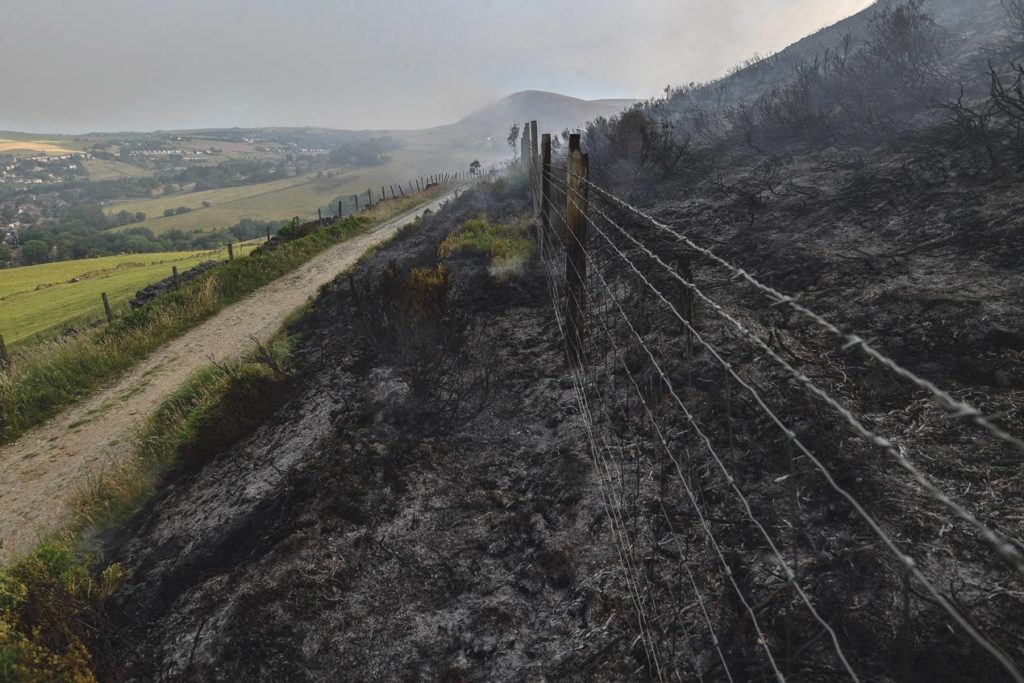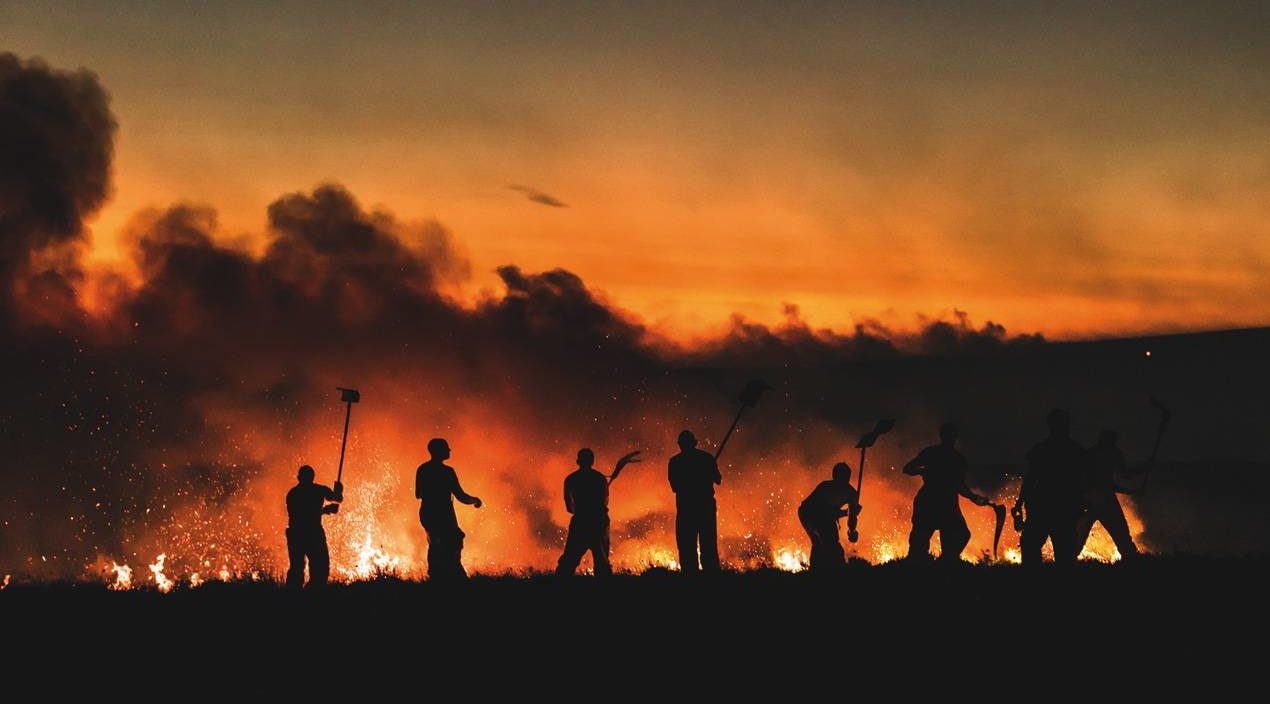For peat’s sake
When palls of smoke eventually clear from the infernos raging over Pennine moorland the deeply scorched earth left behind will be restored with techniques discovered in Yorkshire
Every hot summer has its melting roads, its evaporating reservoirs and, most spectacular of all, its apocalyptic fires. And in the blowtorch heatwave of 2018 the wildfires on Saddleworth Moor above Stalybridge and on Winter Hill near Bolton are the most serious outbreaks in the UK since those of the record-breaking hot summer of 1976.
Back then parts of the North York Moors began to look like a scene from the sci-fi film The Day The Earth Caught Fire. The conflagration was especially bad on Rosedale Moor, where it eventually covered 1,500 acres and burned so far down into the peat that the North Yorkshire moor smouldered for months.
In the North York Moors National Park the impact of the 1976 fires can still be seen in places
This year’s fires began with a phone call to Greater Manchester Fire and Rescue Service at 8.19pm on Sunday 24 June. At first, the outbreak was said to have been caused by tinder-dry grass igniting under a sun that had sweltered the west side of the Pennines with a daytime temperature of 23C. Police have since said they are treating the fire as arson and have received reports of a “a group of males” lighting a fire shortly before the 999 call.
The fire spread across five miles of moorland, and has been fought by fire crews from seven counties as well as more than 100 soldiers and a water-bombing RAF Chinook helicopter. It was soon declared a major incident, with three dozen houses evacuated and several schools closed. But four days later came the fire at Winter Hill on Rivington Moor between Bolton and Darwen, requiring a further 17 fire crews and more help from the army and RAF, and it managed to linger in smouldering pockets across three square miles. A 22-year-old man has been arrested on suspicion of arson.
The great heatwave of 2018 was thus heading for the history books. Aerial pictures shot from drones show scenes of extensive burning and charred and smoking hillsides of the kind we have become used to seeing on TV from Australia and California
When the smoke eventually clears these fire-ravaged swathes of moor will be subjected to expensive restoration work that can take years, even decades, to produce results.
Experts in moorland fires believe the smouldering and the way the outbreaks keeps springing up again after they appear to have been extinguished on the surface is evidence that serious damage has been done to acres of peat below.
Many of the lessons about repairing the damage have been learned in the North York Moors National Park, where the impact of the 1976 fires can still be seen in places and extensive studies have been carried out. But it was the aftermath of a further outbreak on Fylingdales Moor in 2003 that produced the blueprint for moorland restoration now followed elsewhere.

Rob Stoneman, chair of the Yorkshire Peat Partnership – an umbrella group of organisations including Yorkshire Wildlife Trust, the Moors and Dales national parks, Natural England and the Environment Agency preserving and restoring moorland across Yorkshire and the Pennines – says the difficulty in the immediate aftermath of wildfires is that when all the vegetation that protects the black peat layer below has been stripped away, the peat heats up in direct sun, reaching up to 90C in temperature. It then dries out, and desiccated peat cannot be made to support new plant life.
That is why the most urgent work after this summer’s fires will be to rehydrate the peat and make it as wet as possible. To do that drainage ditches will be blocked up to keep rainfall up on the moors and stop it running into valleys. However, since the highly combustible peat layer will have been badly depleted by the fires there will be less peat to work with, and in those areas that experienced the most intense and prolonged fire the peat may well have gone entirely.
In which case, as far as modern moorland restoration is concerned, these locations will be lost for decades. Peat is typically six metres deep and formed from decomposed vegetation and other organic matter laid down over a period of 6,000 years. Its growth rate is just one millimetre a year, or one inch every 25 years in old money.
So most work will concentrate on repairing surface fire damage, but it is a slow, laborious and costly process. What ecologists call nurse grass seed is planted to give the peat something to hang onto, otherwise it will simply be eroded by rainwater and wash off the moor. Once the grasses are established, next comes heather seed to begin the task of recreating – at least visually – the moorland that was consumed by flames. That is considered to be the easy bit, however.
“The next phase,” says Stoneman, “involves going to another area of moorland that’s in reasonable condition and cutting a load of heather brash, as well as sphagnum moss. That’s the sort of thing people unfortunately put in their plant pots at home. We put it in huge plastic bags and use helicopters to fly it onto the moors.
“Then it’s spread by hand into a layer that’s nice and thick. What happens after that is the seed and sphagnum fragments drop down onto the bare peat, which is protected by the mat of heather brash. It can take a number of years to become established, though, and it’s expensive. We’re talking about £1,000 a hectare, which is roughly the size of a football pitch.”
Those whose job it will be to survey the blackened landscapes of Saddleworth Moor and Winter Hill might not immediately appreciate the thought that good things can emerge from the fires, but in the North York Moors the Flyingdales fire of 2003 had surprising consequences that were not all unwelcome.
“What we found was massively interesting,” says the North York Moors National Park’s Rachel Pickering. “All sorts of archaeological relics came to light when the peat had burned away – things like cup and ring marked stones, prehistoric hut circles. It was really devastating from an ecological point of view but we were surprised by what was found under the top layer of peat. Another unforeseen outcome was that the grass we planted attracted birds like skylarks.”
When there was a serious fire on Ilkley Moor in 2006, it was to Pickering’s team on the North York Moors that Bradford’s countryside manager Danny Jackson went for guidance on how to repair the damage.
“The best bit of advice they gave us was not to rush in and spend loads of money with complicated restoration schemes but to stand back and see what happens naturally,” he says. “We applied this approach to some degree and 12 years later the burnt area has recovered to something approaching the pre-fire habitat. We also translocated heather and seed from another moor and spread it across part of the affected area.”
While repairing damage is now the first priority across the Pennines, thought will be given more widely on how to stop the spread of moorland fires. The way that’s favoured by conservationists is to “re-wet” large areas of uplands by restoring blanket bog, a vegetative skin that includes moisture-retaining sphagnum moss. This acts as a gigantic unsqueezed sponge that would make it hard for future blazes to survive.
There is also a school of thought that the only really effective fire breaks would be 150-300ft wide and dug down into the mineral layer below the peat.
Jackson says: “Given that a lot of our uplands are protected and designated as national parks and areas of outstanding natural beauty Natural England would need to think long and hard before consenting to such measures as it would result in damage to the peat resource. That would have to be balanced against damage by wildfire.”

Leave a reply
Your email address will not be published.